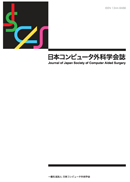Volume 15, Issue 3
Displaying 1-11 of 11 articles from this issue
- |<
- <
- 1
- >
- >|
Preface
-
Article type: Preface
2013 Volume 15 Issue 3 Pages 267
Published: November 15, 2013
Released on J-STAGE: March 31, 2014
Download PDF (1044K) -
Article type: Preface
2013 Volume 15 Issue 3 Pages 268
Published: November 15, 2013
Released on J-STAGE: March 31, 2014
Download PDF (1043K)
Reviews
-
Article type: Review
2013 Volume 15 Issue 3 Pages 271-275
Published: November 15, 2013
Released on J-STAGE: March 31, 2014
Download PDF (1414K) -
Article type: Review
2013 Volume 15 Issue 3 Pages 277-280
Published: November 15, 2013
Released on J-STAGE: March 31, 2014
Download PDF (1451K)
Original
-
Article type: Original
2013 Volume 15 Issue 3 Pages 281-288
Published: November 15, 2013
Released on J-STAGE: March 31, 2014
Download PDF (3279K)
From JSCAS
-
2013 Volume 15 Issue 3 Pages 289-290
Published: November 15, 2013
Released on J-STAGE: March 31, 2014
Download PDF (1462K) -
2013 Volume 15 Issue 3 Pages 291-292
Published: November 15, 2013
Released on J-STAGE: March 31, 2014
Download PDF (1282K) -
2013 Volume 15 Issue 3 Pages 293-296
Published: November 15, 2013
Released on J-STAGE: March 31, 2014
Download PDF (1035K) -
2013 Volume 15 Issue 3 Pages 297-298
Published: November 15, 2013
Released on J-STAGE: March 31, 2014
Download PDF (1624K) -
2013 Volume 15 Issue 3 Pages 299-304
Published: November 15, 2013
Released on J-STAGE: March 31, 2014
Download PDF (1155K) -
2013 Volume 15 Issue 3 Pages 314
Published: November 15, 2013
Released on J-STAGE: March 31, 2014
Download PDF (1027K)
- |<
- <
- 1
- >
- >|
